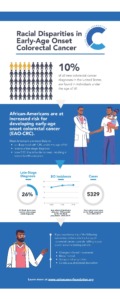Systemic racism remains an impediment for the progress of public health in the U.S. Racial disparities continue to reduce access to quality healthcare in the country, as was confirmed by a recently published study.
The study, published in the Journal of Clinical Oncology (JCO), found that young Black individuals (18-49 years) in the U.S. diagnosed with colorectal cancer (CRC) have a higher death rate than their White counterparts. The authors suggest that young Black patients with CRC are less likely to receive timely and guideline-concordant care (guideline-concordant is the minimal treatment patients should receive according to the National Comprehensive Cancer Network standards), which may be responsible for the increased mortality in that population. Specifically, the study found that Black CRC patients had longer times to receive adjuvant chemotherapy for colon cancer and neoadjuvant chemoradiation for rectal cancer compared to White patients.
Racial disparity has a long and profound history in the U.S., affecting everything from the housing sector to the criminal justice system to the healthcare system and the economy. But when it comes to healthcare, it becomes even more worrisome and disturbing because the system’s ongoing inequities are impeding the progress made through years of public health effort. As a national goal, the Agency for Healthcare Research and Quality is dedicated to reducing racial disparities in health outcomes across the country.
Interestingly, the American Cancer Society reports that, with the exception of pancreatic and kidney cancer, Black people had lower survival rates than White people for all cancer types.
Barriers to CRC Screening and Treatment
Back to the JCO study – the authors found that access to CRC screening is difficult for Black people in the U.S. for a number of reasons, including:
- Health insurance coverage: Often your health insurance determines the type of healthcare you receive. However, obtaining quality private health insurance is primarily dependent on having a job. But when it comes to employment, a substantial percentage of Black people are disadvantaged. Compared to White people, Black people have the highest unemployment rate in the country and are more likely to work in blue-collar jobs. Consequently, Black individuals have lower rates of private insurance coverage.
- Facility type: Black people are more likely to receive treatment at facilities with limited resources and are less likely to have access to high-performing facilities like teaching hospitals and cancer centers with a National Cancer Institute designation. However, research indicates that there could be a 5% reduction in the disparity in the provision of guideline-concordant care if Black and White patients were treated in the same healthcare facilities.
- Access to specialists/Lack of diversity in the medical workforce: For Black patients with metastatic CRC, fewer consultations with specialists and subsequent multimodality therapy treatments are provided. Nonetheless, even in cases when the rates of specialist visits are comparable to those of White patients, Black people are less likely to undergo treatment for CRC. A lack of cultural sensitivity and diversity in the medical workforce erodes good patient-provider communication, including the kind and caliber of information that clinicians deliver to patients, and makes the health care system appear less trustworthy. Disparities in patients’ access to high-quality care can be made worse by this, which can result in clinicians making insufficient treatment recommendations and creating obstacles to treatment adherence for patients from marginalized populations.
Over the years, a lot of work has been done to boost access to healthcare and remove barriers that might prevent it. Despite that, racial disparities in healthcare in the U.S. remain. However, no one should be denied access to high-quality healthcare due to the color of their skin or race. More work is needed to eradicate the disparities that Black Americans and other minority races face throughout the country.
Emmanuel Olaniyan is a Colorectal Cancer Prevention Intern with the Colon Cancer Foundation.
Photo credit: Nathan Dumlao on Unsplash




